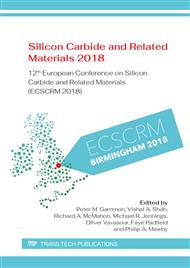p.588
p.592
p.596
p.600
p.605
p.609
p.613
p.617
p.621
Design Optimization of 1.2kV 4H-SiC Trench MOSFET
Abstract:
In a trench MOSFET structure, p+ trench bottom implant (also called p+ shielding region) is commonly used to protect the gate oxide from high electric field stress, however, if the design and fabrication process are not optimized properly, the p+ shielding region together with n-drift and the p-base region will form a parasitic JFET which severely degrades the on-state performance of the device. This paper presents this parasitic JFET effect with experimental results and the optimization work that has been done to eliminate the parasitic JFET.
Info:
Periodical:
Pages:
605-608
Citation:
Online since:
July 2019
Keywords:
Price:
Сopyright:
© 2019 Trans Tech Publications Ltd. All Rights Reserved
Share:
Citation:


